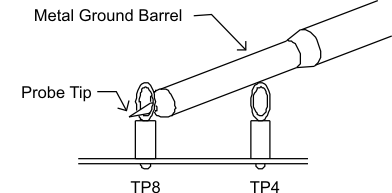SLVU432A February 2011 – January 2022 TPS53125 , TPS53126 , TPS53127 , TPS53128 , TPS53129
- Trademarks
- 1 Introduction
- 2 Electrical Performance Specifications
- 3 Schematics
-
4 Connector and Test Point Descriptions
- 4.1 Enable Switches – SW1 and SW2
- 4.2 Switching Frequency Select Switch – SW3
- 4.3
Test Point Descriptions
- 4.3.1 Input Voltage Monitoring – TP3 and TP9
- 4.3.2 Channel-1 Output Voltage Monitoring – TP4 and TP8
- 4.3.3 Channel-2 Output Voltage Monitoring – TP6 and TP7
- 4.3.4 Soft-Start Voltage Monitoring – TP1, TP2, and TP3
- 4.3.5 Switching Node Monitoring – TP3, TP5, and TP11
- 4.3.6 5-V Regulator Output Monitoring – TP3 and TP10
- 5 Test Setup
- 6 Test Procedure
- 7 Performance Data and Typical Characteristic Curves
- 8 EVM Assembly Drawings and Layout
- 9 Bill of Materials
- 10Revision History
4.3.2 Channel-1 Output Voltage Monitoring – TP4 and TP8
The TPS53129EVM-621 provides two test points for measuring the voltage generated at the VOUT1 output by the module. This allows the user to measure the actual output voltage without losses from output cables and connectors. Measure all DC output voltage measurements between TP8 and TP4. To use TP8 and TP4, connect a voltmeter positive terminal to TP8 and negative terminal to TP4.
For output ripple measurements, TP8 and TP4 allow a user to limit the ground loop area by using the tip and barrel measurement technique shown in Figure 4-1.
 Figure 4-1 Tip and Barrel Measurement for Output Voltage Ripple
Figure 4-1 Tip and Barrel Measurement for Output Voltage Ripple